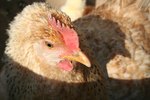
The red wattles that hang beneath their bills and the red combs upon their heads make chickens readily identifiable. However, few people are aware of why chickens have wattles and combs. They might look funny to human eyes, but wattles and combs perform functions vital to the chickens’ survival.
Cooling
Wattles are part of chickens' heat regulation system. They are unable to sweat. Instead they cool themselves through their blood circulation: the wattles and combs are thick with capillaries and veins for the overheated blood to pass through. It is air-cooled as it passes through these blood vessels. In turn, this cooler blood reduces the chicken’s internal temperature. This process is responsible for the bright red color of the chicken’s wattles and comb.
Indicating Sexual Maturity
Chicks hatch without wattles or combs. Combs typically appear before wattles, at about the age of 3 weeks. Chicks that develop their combs early on are usually cockerels—male chicks. Developing combs appear yellowish; however, cockerels’ combs and wattles will often begin to redden as early as 5 or 6 weeks of age. Pullets—female chicks—usually start laying eggs about the same time as their combs and wattles turn bright red or pink.
Attracting Mates
Mature roosters usually possess much larger wattles than hens. Hens are attracted to roosters whose wattles have certain qualities. Roosters with extremely floppy wattles or that are missing wattles entirely are not as attractive to hens. Some research shows that the size of a rooster’s comb may be correlated with the amount of testosterone present in that rooster.
Indicating Health
Wattles provide a means of determining chickens’ health. A healthy chicken will have brightly colored wattles and comb that are free of discoloration or blemishes. Chickens that are not feeling well or that are molting may have shrunken and pale wattles. Wattles may reveal many symptoms of various diseases, including scabs, lesions, hardened skin, bluish discoloration or warts. Any unusual growth or appearance on a chicken’s wattles should be taken as a sign that a veterinary exam is warranted, as many diseases can infect an entire flock if left untreated.
References
- Community Chickens: A Chicken’s Comb—More than a Fashion Statement
- BackYard Chickens Community: All About Chicken Combs—Single, Pea, Rose, V-Shaped, Etc.
- Success with Poultry: How to Tell the Sex of Chickens
- Surprising Science: Why Roosters Have Wattles
- Chicken Run Rescue: Physical Exam for Chickens [PDF]
Photo Credits
-
Digital Vision./Digital Vision/Getty Images



